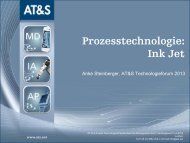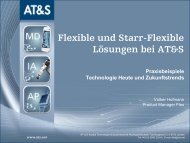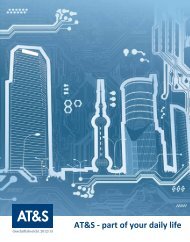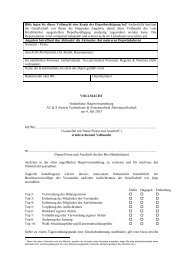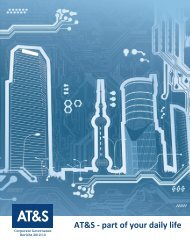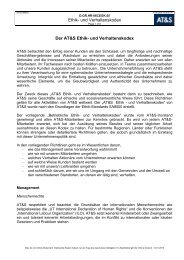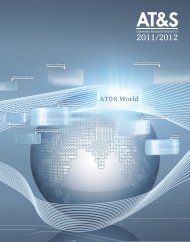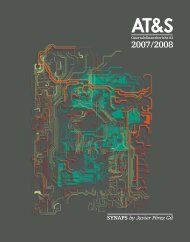AT&S World
AT&S World
AT&S World
You also want an ePaper? Increase the reach of your titles
YUMPU automatically turns print PDFs into web optimized ePapers that Google loves.
From the time of their availability for use, the assets are depreciated<br />
on a straight-line basis over their expected useful lives.<br />
Depreciation is charged on a pro rata temporis basis. Land is not<br />
subject to depreciation.<br />
The depreciation method is uniform for the Group and based on<br />
the following useful lives:<br />
Plants and buildings 15-50 years<br />
Machinery and technical equipment 5-15 years<br />
Tools, fixtures, furniture and<br />
office equipment 3-10 years<br />
Depreciation periods and methods are reviewed annually at the<br />
end of the financial year.<br />
Expected costs for dismantling and removing assets are capitalised<br />
as part of acquisition costs and accounted for by a provision,<br />
provided that there is a legal or factual obligation against third<br />
parties and that a reasonable estimate can be made.<br />
According to IAS 17 “Leases”, leased assets for which the Group<br />
bears substantially all the risks and rewards of ownership are<br />
capitalised at their fair value or the lower present value of the<br />
minimum lease payments. Depreciation is effected over the useful<br />
life of the asset. If at the beginning of the lease it is not sufficiently<br />
certain that the title will pass to the lessee, the leased<br />
asset will be depreciated over the shorter of the two periods, the<br />
lease term or useful life. Financial obligations resulting from future<br />
lease payments are discounted and carried as liability. Current<br />
lease payments are split into repayment and financing costs.<br />
Leased assets under all other lease agreements are classified as<br />
operating leases and attributed to the lessor. Lease payments are<br />
recognised as an expense.<br />
Profits or losses resulting from the closure or retirement of noncurrent<br />
assets, which arise from the difference between the recoverable<br />
and the carrying amounts, are credited or charged to<br />
the income statement.<br />
Consolidated Financial Statements as of 31 March 2011<br />
g. Intangible assets<br />
Patents, trademarks and licenses<br />
Expenditures on acquired patents, trademarks and licenses are<br />
capitalised at cost, including incidental acquisition expenses,<br />
and amortised on a straight-line basis over their useful lives, generally<br />
between 2 and 10 years. Amortisation terms and methods<br />
are reviewed annually at the end of the financial year.<br />
Goodwill<br />
Goodwill, which represents the excess of the cost of an acquisition<br />
over the fair value of the Group’s share of the net assets acquired<br />
at the date of acquisition, is included in intangible assets<br />
at the date of acquisition (refer to a. Consolidation principles).<br />
Research and development costs<br />
Research costs are expensed as incurred and charged to cost of<br />
sales. Development expenditure is also expensed as incurred. An<br />
intangible asset arising from development shall be recognised<br />
if, and only if, an entity can demonstrate all of the following:<br />
the technical feasibility of completing the intangible asset so<br />
that it will be available for use or sale.<br />
its intention to complete the intangible asset and use or sell it.<br />
its ability to use or sell the intangible asset.<br />
how the intangible asset will generate probable future economic<br />
benefits.<br />
the availability of adequate technical, financial and other resources<br />
to complete the development and to use or sell the<br />
intangible asset.<br />
its ability to measure reliably the expenditure attributable to<br />
the intangible asset during its development.<br />
No capitalised development costs have been considered in these<br />
consolidated financial statements.<br />
63



